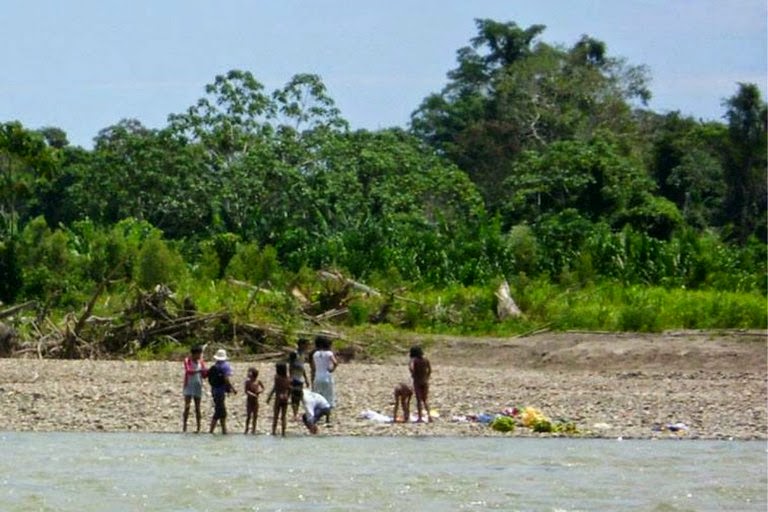This is the full text, with additional photos, of a three-part series published concurrently by Indian Country Today
Versión en castellano
Versión en castellano
1. Missionaries and ‘human safaris’ initiate contact in Peru
It feels like a déjà vu: naked youths from an isolated indigenous group step warily through shallow water and approach the strangers. Emboldened by curiosity, or hunger perhaps, they accept colorful clothing and gifts of food, not knowing that they may be carrying an epidemiological bomb back to their people in the forest. And yet the apparent good intentions of these friendly outsiders may be motivated by a hidden agenda: religious prosylization or territorial control. Moreover, initiating contact with isolated indigenous peoples is a violation of Peruvian regulations.
The scene is strikingly similar to dramatic recent events in a nearby region along Brazil’s border with Peru. On June 27, a group of young Txapanawa warriors, hitherto isolated, established contact with an Ashaninka community on the upper Envira River.
However there are important differences in these two superficially similar episodes: the Txapanawa[1] initiated contact of their own accord, walking for miles to seek aid from the neighboring indigenous population after apparently being attacked by loggers or perhaps (according to preliminary investigations in Brazil) drug traffickers based in Peru. Moreover, the Ashaninka called immediately on an experienced team from Brazil’s Federal Indian Agency, FUNAI, to help mediate the contact, provide medical care for the inevitable flu epidemic that struck the intrepid youths, and develop a long-term strategy to protect the group. The contact with the Mashco-Piro has been carried out informally, irresponsibly, and against official norms, by tourists and local people without the authority or training to handle the potentially genocidal consequences of such a situation.
The indigenous organization FENAMAD, in conjunction with Survival International, recently published photographs on its FaceBook page taken on September 6 showing a group of Mashco-Piro children receiving clothes and gifts from a local indigenous woman from the village of Diamante who is affiliated with an evangelical missionary organization that has been intent on contacting the Mashco-Piro for some time. The people of Diamante on the Madre de Dios River are Piro, and their language is close enough to Mashco-Piro to allow for mutual communication. Some inhabitants of Diamante have been trying to contact the Mashco-Piro for almost 25 years, but only in the past year have the Mashco-Piro responded to such efforts with anything other than hostility: several local people have been wounded by Mashco-Piro arrows, and one man was killed in 2011.
The FENAMAD team was using a boat supplied by the U.N. Development Program (UNDP) to patrol the Amarakaeri Communal Reserve, which shares a border with Manu National Park. According to their report, in addition to the Piro woman, they also surprised two tourism boats and a group of tourists on the same beach. The tourists and tour boats left immediately leaving only the Piro woman, named Nelly, on the beach with five Mashco-Piro youths wearing their new clothes.
 |
| Mashco Piro children taking items from tourism boat (Photo: Jaime Corisepa/FENAMAD) |
When questioned about her activities, Nelly replied that she has been taking bananas to the Mashco-Piro because they ask her to. The Mashco-Piro children were waiting on the beach while their parents hunted in the forest nearby. The clothes, she said, were left by the tourists traveling in a boat operated by Expediciones Vilca. The Mashco-Piro have become a kind of tourist attraction in the region, and some tour operators have even offered clandestine “human safaris” for tourists to view and photograph the Mashco-Piro, much as they would a jaguar or other rare animal. Some tourists have allegedly left soda pop and even beer on the beach as presents to the Mashco-Piro. In one recent photograph, a young Mashco-Piro woman appears with a large wound on her leg, apparently caused by the tropical disease leishmaniasis.
In a previous episode highlighting the dangerous consequences of human safaris, a film crew associated with the Discovery Channel trekked to an isolated indigenous community in Manu Park in October of 2007, specifically violating the terms of its authorizations, and was alleged to have contaminated the group with a flu virus that killed four children and left dozens ill.
FENAMAD representative Cesar Augusto Jojajé decried the negligence of the Peruvian authorities in the face of this precarious situation: “The government is absent in this region. We want the authorities to assume their responsibilities and implement the promised operational plan [of the Amarakaeri Communal Reserve] which establishes among its clauses the integrity of the Mashco-Piro people’s territory.”
2. From head-ball to hunter-gatherers: the true story of the Mashco-Piro
 |
| A withered rubber sphere used by the Mashco-Piro to play “head ball,” originally collected by Shaco Flores (Photo: Fabio Jacob/Museu Paraense Emílio Goeldi) |
However the situation becomes more complex once we understand that Nelly, the indigenous woman who initiated contact with the group, is in fact half Mashco-Piro herself: her father was kidnapped in the forest as a young child and taken away from the group by Diamante villagers in the 1970s as part of their attempt to “civilize” the Mashco-Piro, whom the Piro view as wayward brethren. Re-baptized with a Spanish name, Nelly’s father was raised among the Piro and never went back to his people; indeed he has no more memory of his life among them. Nelly has allied herself with a local evangelical missionary group, including a pastor and his wife who now reside in Diamante, in the hopes of helping “her people” overcome the hunger, isolation and fear they supposedly now live in.

